Damage Fracture Characterization of Asphalt Mixtures Considering Freeze–Thaw Cycling and Aging Effects Based on Acoustic Emission Monitoring
Abstract
:1. Introduction
2. Materials and Methods
2.1. Raw Materials and Specimens
2.2. Testing Procedure
2.2.1. Freeze–Thaw Testing Procedure
2.2.2. Aging Test Procedure
2.2.3. Acoustic Emission and Indirect Tensile Tests Procedure
2.3. AE Parameters
3. Results and Discussions
3.1. Effect of Freeze–Thaw Cycling on the Damage Mechanisms of the Asphalt Mixture
3.1.1. Failure Loads and Failure Strains
3.1.2. Energy
3.1.3. Cumulative Energy
3.1.4. Peak Frequency
3.2. Effect of Aging on Damage Mechanisms of Asphalt Mixture
3.2.1. Failure Loads and Failure Strains
3.2.2. Energy
3.2.3. Cumulative Energy
3.2.4. Peak Frequency
4. Conclusions
- The failure loads and failure strains of the asphalt mixture decreased as the number of F–T cycles increased; with the increase in aging time, the failure loads of asphalt mixture increased, while the failure strains decreased.
- The damage process for all specimens can be subdivided into three stages, and the fracture characteristics of the asphalt mixture in the comparison group were characterized by a sudden and pronounced fracture at the final stage.
- The F–T cycling effect altered the damage characteristics of the asphalt mixture, leading to early damage under the splitting load, intensifying the formation of micro-cracks, promoting the expansion of macro-cracks and advancing the debonding of the matrix from the aggregates.
- The aging effect also influenced the fracture characteristics of the asphalt mixture under splitting load, weakening the adhesion between the matrix and the aggregates, exacerbating the generation of micro-cracks at an early stage, accelerating the rapid accumulation of macro-cracks and leading to earlier damage to the asphalt mixture.
- The acoustic emission technique can monitor the damage evolution of the asphalt mixture in real-time, which helps to further clarify the mechanism of freeze–thaw cycling and aging effects on the asphalt mixture.
Author Contributions
Funding
Informed Consent Statement
Data Availability Statement
Conflicts of Interest
References
- Feng, D.; Yi, J.; Wang, D.; Chen, L. Impact of Salt and Freeze–Thaw Cycles on Performance of Asphalt Mixtures in Coastal Frozen Region of China. Cold Reg. Sci. Technol. 2010, 62, 34–41. [Google Scholar] [CrossRef]
- You, L.; You, Z.; Dai, Q.; Guo, S.; Wang, J.; Schultz, M. Characteristics of Water-Foamed Asphalt Mixture under Multiple Freeze-Thaw Cycles: Laboratory Evaluation. J. Mater. Civ. Eng. 2018, 30, 04018270. [Google Scholar] [CrossRef]
- Yi, J.; Shen, S.; Muhunthan, B.; Feng, D. Viscoelastic–Plastic Damage Model for Porous Asphalt Mixtures: Application to Uniaxial Compression and Freeze–Thaw Damage. Mech. Mater. 2014, 70, 67–75. [Google Scholar] [CrossRef]
- Sirin, O.; Paul, D.K.; Kassem, E. State of the Art Study on Aging of Asphalt Mixtures and Use of Antioxidant Additives. Adv. Civ. Eng. 2018, 2018, 3428961. [Google Scholar] [CrossRef] [Green Version]
- Wang, W.; Cheng, Y.; Ma, G.; Tan, G.; Sun, X.; Yang, S. Further Investigation on Damage Model of Eco-Friendly Basalt Fiber Modified Asphalt Mixture under Freeze-Thaw Cycles. Appl. Sci. 2018, 9, 60. [Google Scholar] [CrossRef] [Green Version]
- Wang, W.; Wang, L.; Xiong, H.; Luo, R. A Review and Perspective for Research on Moisture Damage in Asphalt Pavement Induced by Dynamic Pore Water Pressure. Constr. Build. Mater. 2019, 204, 631–642. [Google Scholar] [CrossRef]
- Guo, Q.; Li, G.; Gao, Y.; Wang, K.; Dong, Z.; Liu, F.; Zhu, H. Experimental Investigation on Bonding Property of Asphalt-Aggregate Interface under the Actions of Salt Immersion and Freeze-Thaw Cycles. Constr. Build. Mater. 2019, 206, 590–599. [Google Scholar] [CrossRef]
- Xu, H.; Guo, W.; Tan, Y. Internal Structure Evolution of Asphalt Mixtures during Freeze–Thaw Cycles. Mater. Des. 2015, 86, 436–446. [Google Scholar] [CrossRef]
- Cheng, Y.; Wang, W.; Gong, Y.; Wang, S.; Yang, S.; Sun, X. Comparative Study on the Damage Characteristics of Asphalt Mixtures Reinforced with an Eco-Friendly Basalt Fiber under Freeze-Thaw Cycles. Materials 2018, 11, 2488. [Google Scholar] [CrossRef] [Green Version]
- Fakhri, M.; Ali Siyadati, S.; Aliha, M.R.M. Impact of Freeze–Thaw Cycles on Low Temperature Mixed Mode I/II Cracking Properties of Water Saturated Hot Mix Asphalt: An Experimental Study. Constr. Build. Mater. 2020, 261, 119939. [Google Scholar] [CrossRef]
- Karimi, M.M.; Dehaghi, E.A.; Behnood, A. A Fracture-Based Approach to Characterize Long-Term Performance of Asphalt Mixes under Moisture and Freeze-Thaw Conditions. Eng. Fract. Mech. 2021, 241, 107418. [Google Scholar] [CrossRef]
- Gao, J.; Fan, T.; Ping, K. Influence of Freeze–Thaw Cycles on Thermal Conductivity, Water Permeability and Mechanical Properties of Asphalt Mixtures. Iran. J. Sci. Technol. Trans. Civ. Eng 2021, 45, 953–962. [Google Scholar] [CrossRef]
- Mohammadafzali, M.; Ali, H.; Musselman, J.A.; Sholar, G.A.; Massahi, A. The Effect of Aging on the Cracking Resistance of Recycled Asphalt. Adv. Civ. Eng. 2017, 2017, 7240462. [Google Scholar] [CrossRef] [Green Version]
- Zhang, H.; Chen, Z.; Xu, G.; Shi, C. Evaluation of Aging Behaviors of Asphalt Binders through Different Rheological Indices. Fuel 2018, 221, 78–88. [Google Scholar] [CrossRef]
- Yusoff, N.I.M.; Breem, A.A.S.; Alattug, H.N.M.; Hamim, A.; Ahmad, J. The Effects of Moisture Susceptibility and Ageing Conditions on Nano-Silica/Polymer-Modified Asphalt Mixtures. Constr. Build. Mater. 2014, 72, 139–147. [Google Scholar] [CrossRef]
- Safaei, F.; Lee, J.; Nascimento, L.A.H.D.; Hintz, C.; Kim, Y.R. Implications of Warm-Mix Asphalt on Long-Term Oxidative Ageing and Fatigue Performance of Asphalt Binders and Mixtures. Road Mater. Pavement Des. 2014, 15, 45–61. [Google Scholar] [CrossRef]
- Baek, C.; Underwood, B.S.; Kim, Y.R. Effects of Oxidative Aging on Asphalt Mixture Properties. Transp. Res. Rec. 2012, 2296, 77–85. [Google Scholar] [CrossRef] [Green Version]
- Sirin, O.; Ohiduzzaman, M.; Kassem, E.; Paul, D.K. Comprehensive Evaluation of Long-Term Aging of Asphalt Mixtures in Hot Climatic Condition. Road Mater. Pavement Des. 2020, 21, 927–949. [Google Scholar] [CrossRef]
- Lv, S.; Liu, C.; Zheng, J.; You, Z.; You, L. Viscoelastic Fatigue Damage Properties of Asphalt Mixture with Different Aging Degrees. KSCE J. Civ. Eng. 2018, 22, 2073–2081. [Google Scholar] [CrossRef]
- Geng, J.; Chen, M.; Xia, C.; Liao, X.; Chen, Z.; Chen, H. Aging Characteristics of Crumb Rubber Modified Asphalt Binder and Mixture with Regenerating Agent. Constr. Build. Mater. 2021, 299, 124299. [Google Scholar] [CrossRef]
- Amani, S.; Kavussi, A.; Karimi, M.M. Effects of Aging Level on Induced Heating-Healing Properties of Asphalt Mixes. Constr. Build. Mater. 2020, 263, 120105. [Google Scholar] [CrossRef]
- Movilla-Quesada, D.; Muñoz, O.; Raposeiras, A.C.; Castro-Fresno, D. Thermal Suspectability Analysis of the Reuse of Fly Ash from Cellulose Industry as Contribution Filler in Bituminous Mixtures. Constr. Build. Mater. 2018, 160, 268–277. [Google Scholar] [CrossRef] [Green Version]
- Cheng, Y.; Yu, D.; Tan, G.; Zhu, C. Low-Temperature Performance and Damage Constitutive Model of Eco-Friendly Basalt Fiber–Diatomite-Modified Asphalt Mixture under Freeze–Thaw Cycles. Materials 2018, 11, 2148. [Google Scholar] [CrossRef] [PubMed] [Green Version]
- Raposeiras, A.C.; Movilla-Quesada, D.; Muñoz-Cáceres, O.; Andrés-Valeri, V.C.; Lagos-Varas, M. Production of Asphalt Mixes with Copper Industry Wastes: Use of Copper Slag as Raw Material Replacement. J. Environ. Manag. 2021, 293, 112867. [Google Scholar] [CrossRef]
- Behnia, A.; Chai, H.K.; Shiotani, T. Advanced Structural Health Monitoring of Concrete Structures with the Aid of Acoustic Emission. Constr. Build. Mater. 2014, 65, 282–302. [Google Scholar] [CrossRef]
- Noorsuhada, M.N. An Overview on Fatigue Damage Assessment of Reinforced Concrete Structures with the Aid of Acoustic Emission Technique. Constr. Build. Mater. 2016, 112, 424–439. [Google Scholar] [CrossRef]
- Aggelis, D.G.; Verbruggen, S.; Tsangouri, E.; Tysmans, T.; Van Hemelrijck, D. Characterization of Mechanical Performance of Concrete Beams with External Reinforcement by Acoustic Emission and Digital Image Correlation. Constr. Build. Mater. 2013, 47, 1037–1045. [Google Scholar] [CrossRef]
- Prem, P.R.; Murthy, A.R. Acoustic Emission Monitoring of Reinforced Concrete Beams Subjected to Four-Point-Bending. Appl. Acoust. 2017, 117, 28–38. [Google Scholar] [CrossRef]
- Meng, Q.; Zhang, M.; Han, L.; Pu, H.; Nie, T. Effects of Acoustic Emission and Energy Evolution of Rock Specimens Under the Uniaxial Cyclic Loading and Unloading Compression. Rock Mech. Rock Eng 2016, 49, 3873–3886. [Google Scholar] [CrossRef]
- Li, X.; Marasteanu, M.O. Investigation of Low Temperature Cracking in Asphalt Mixtures by Acoustic Emission. Road Mater. Pavement Des. 2006, 7, 491–512. [Google Scholar] [CrossRef]
- Li, X.; Marasteanu, M. The Fracture Process Zone in Asphalt Mixture at Low Temperature. Eng. Fract. Mech. 2010, 77, 1175–1190. [Google Scholar] [CrossRef]
- Arnold, J.W.; Behnia, B.; McGovern, M.E.; Hill, B.; Buttlar, W.G.; Reis, H. Quantitative Evaluation of Low-Temperature Performance of Sustainable Asphalt Pavements Containing Recycled Asphalt Shingles (RAS). Constr. Build. Mater. 2014, 58, 1–8. [Google Scholar] [CrossRef]
- Qiu, X.; Wang, Y.; Xu, J.; Xiao, S.; Li, C. Acoustic Emission Propagation Characteristics and Damage Source Localization of Asphalt Mixtures. Constr. Build. Mater. 2020, 252, 119086. [Google Scholar] [CrossRef]
- Qiu, X.; Xu, J.; Xu, W.; Yang, Q.; Wang, F.; Yuan, J. Diagnosis of Damage Evolution Process for Asphalt Mixtures Using Pattern Recognition with Acoustic Emission Signals. Constr. Build. Mater. 2021, 280, 122536. [Google Scholar] [CrossRef]
- Jiao, Y.; Liu, S.; Fu, L.; Shan, W. Fracture Monitoring of SBS and Crumb Rubber Modified Porous Asphalt Mixtures under Compression and Splitting Testing Using Acoustic Emission Technique. J. Mater. Civ. Eng. 2019, 31, 04019063. [Google Scholar] [CrossRef]
- Jiao, Y.; Zhang, Y.; Zhang, M.; Fu, L.; Zhang, L. Investigation of Fracture Modes in Pervious Asphalt under Splitting and Compression Based on Acoustic Emission Monitoring. Eng. Fract. Mech. 2019, 211, 209–220. [Google Scholar] [CrossRef]
- Cai, X.; Fu, L.; Zhang, J.; Chen, X.; Yang, J. Damage Analysis of Semi-Flexible Pavement Material under Axial Compression Test Based on Acoustic Emission Technique. Constr. Build. Mater. 2020, 239, 117773. [Google Scholar] [CrossRef]
- Ministry of Transport of the People’s Republic of China. Test Methods of Aggregate for Highway Engineering (JTG E42-2005); Ministry of Transport of the People’s Republic of China: Beijing, China, 2005.
- Ministry of Transport of the People’s Republic of China. Standard Test Methods of Bitumen and Bituminous Mixtures for Highway Engineering (JTG E20-2011); Ministry of Transport of the People’s Republic of China: Beijing, China, 2011.
- Ministry of Transport of the People’s Republic of China. Technical Specification for Construction of Highway Asphalt Pavements (JTG F 40-2004); Ministry of Transport of the People’s Republic of China: Beijing, China, 2004.
- He, M.C.; Miao, J.L.; Feng, J.L. Rock Burst Process of Limestone and Its Acoustic Emission Characteristics under True-Triaxial Unloading Conditions. Int. J. Rock Mech. Min. Sci. 2010, 47, 286–298. [Google Scholar] [CrossRef]
- Li, J.; Huang, J.; Niu, J.; Wan, C. Mesoscopic Study on Axial Compressive Damage of Steel Fiber Reinforced Lightweight Aggregate Concrete. Constr. Build. Mater. 2019, 196, 14–25. [Google Scholar] [CrossRef]
- Monti, A.; El Mahi, A.; Jendli, Z.; Guillaumat, L. Mechanical Behaviour and Damage Mechanisms Analysis of a Flax-Fibre Reinforced Composite by Acoustic Emission. Compos. A Appl. Sci. Manuf. 2016, 90, 100–110. [Google Scholar] [CrossRef] [Green Version]
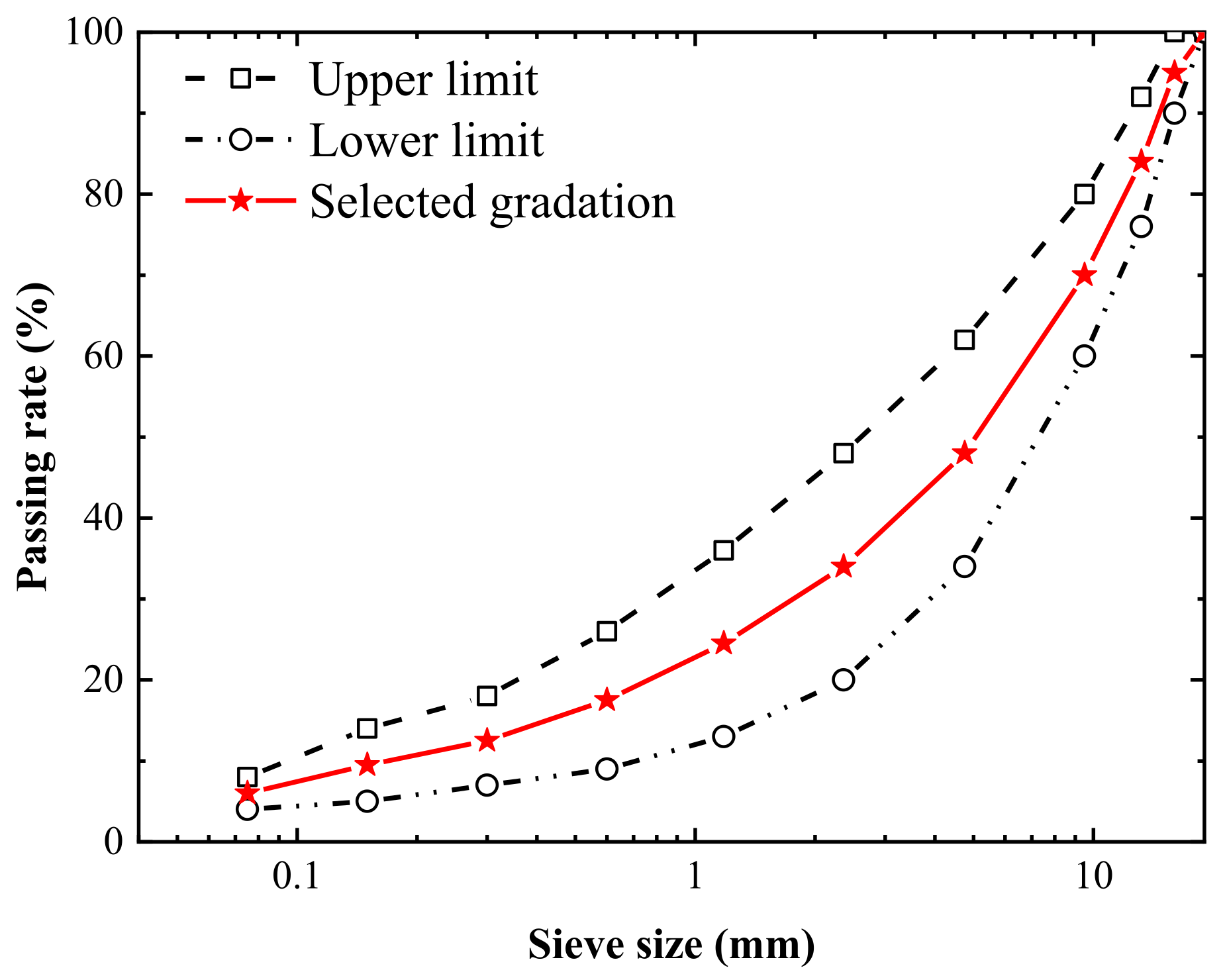
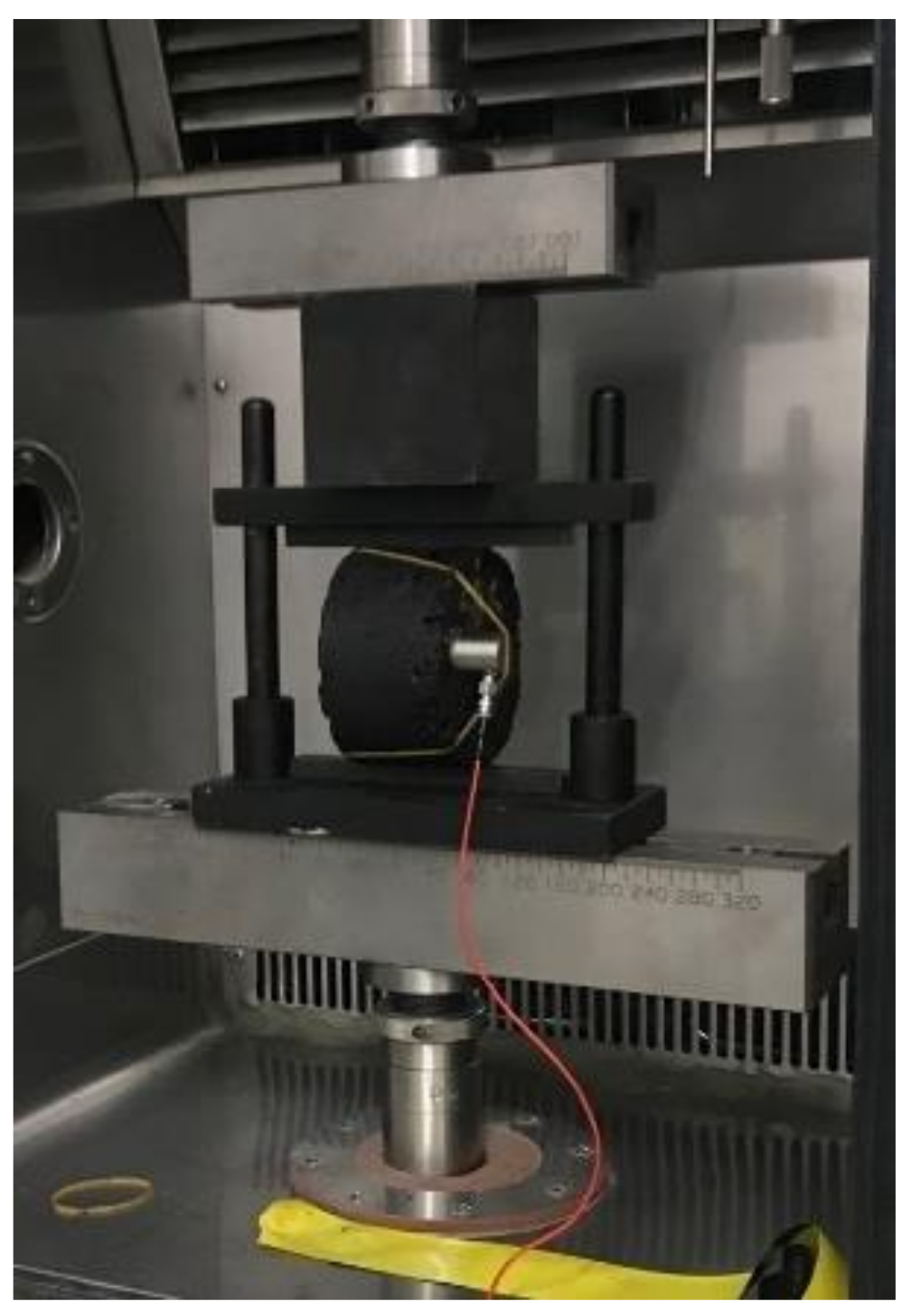
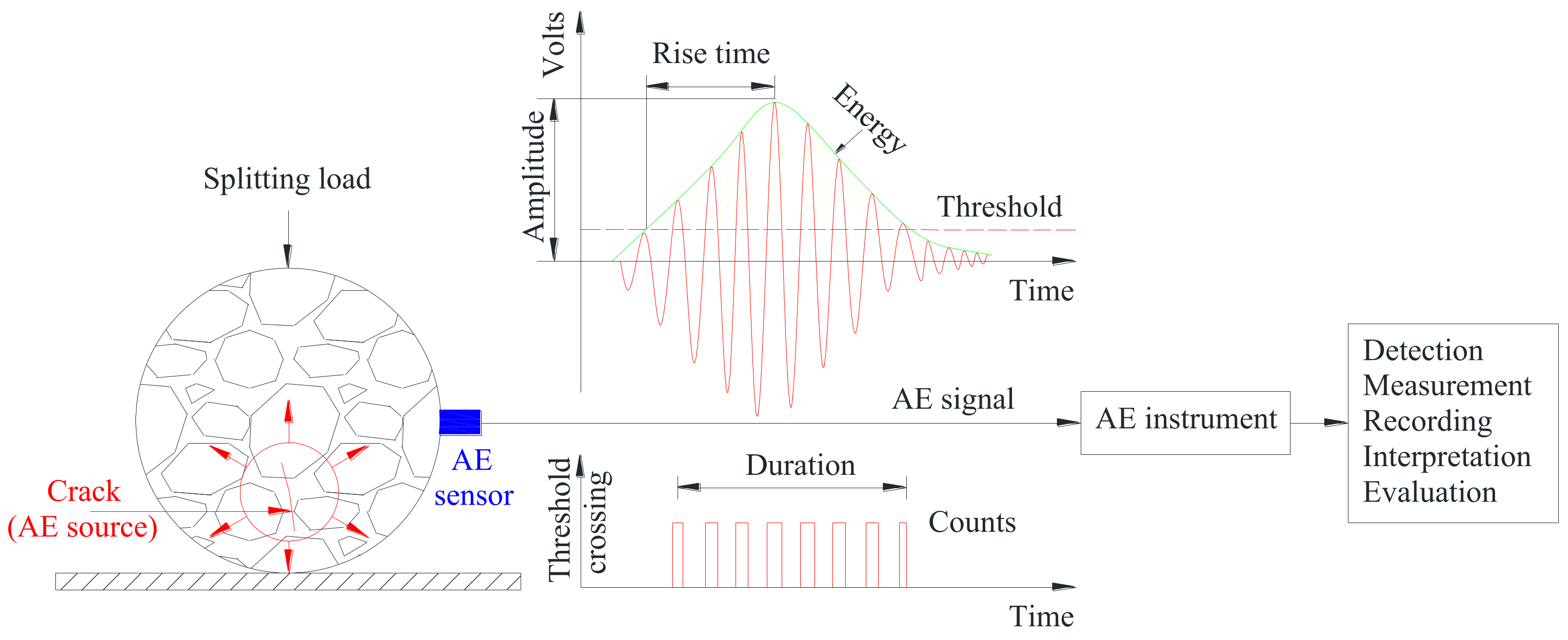


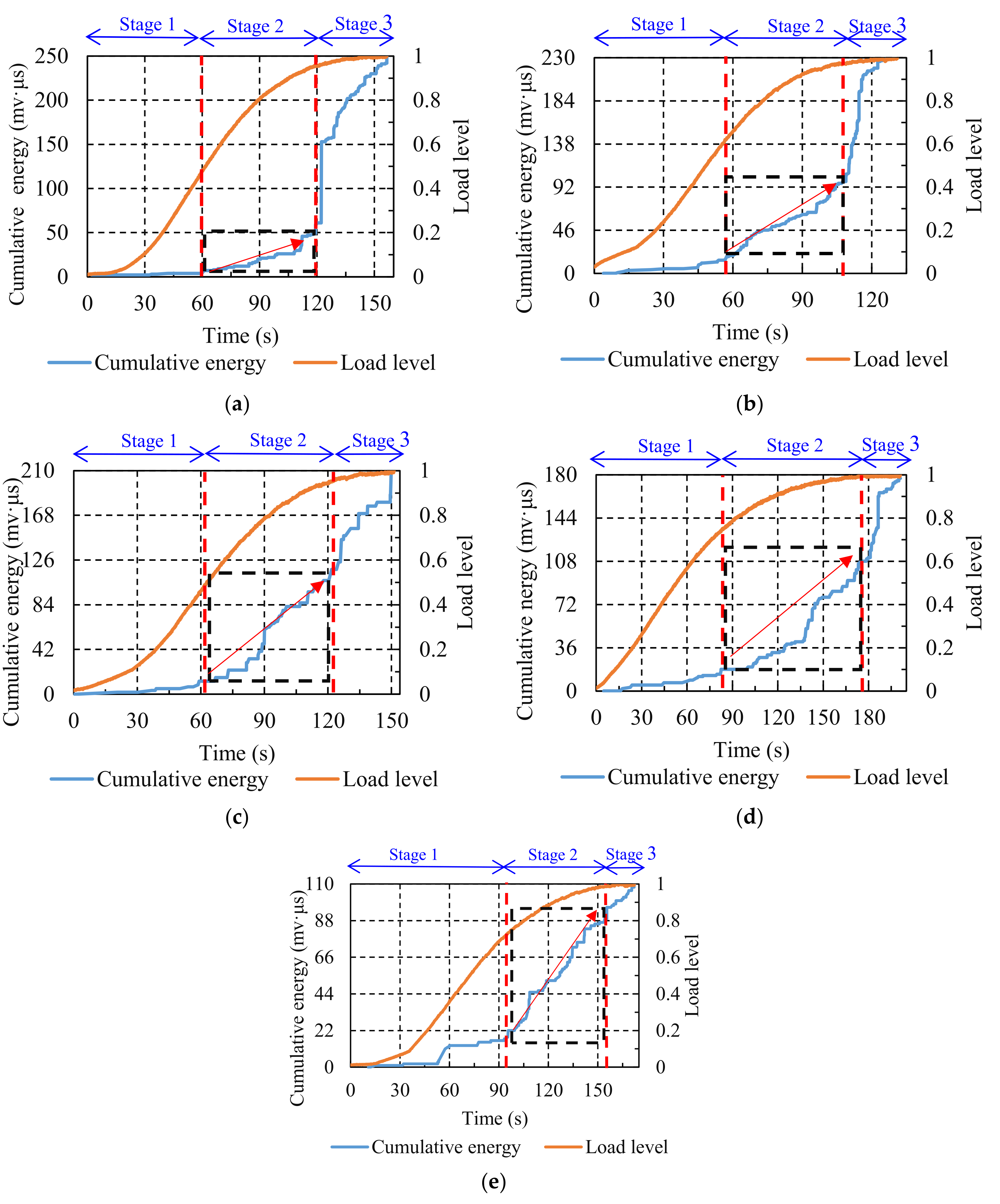

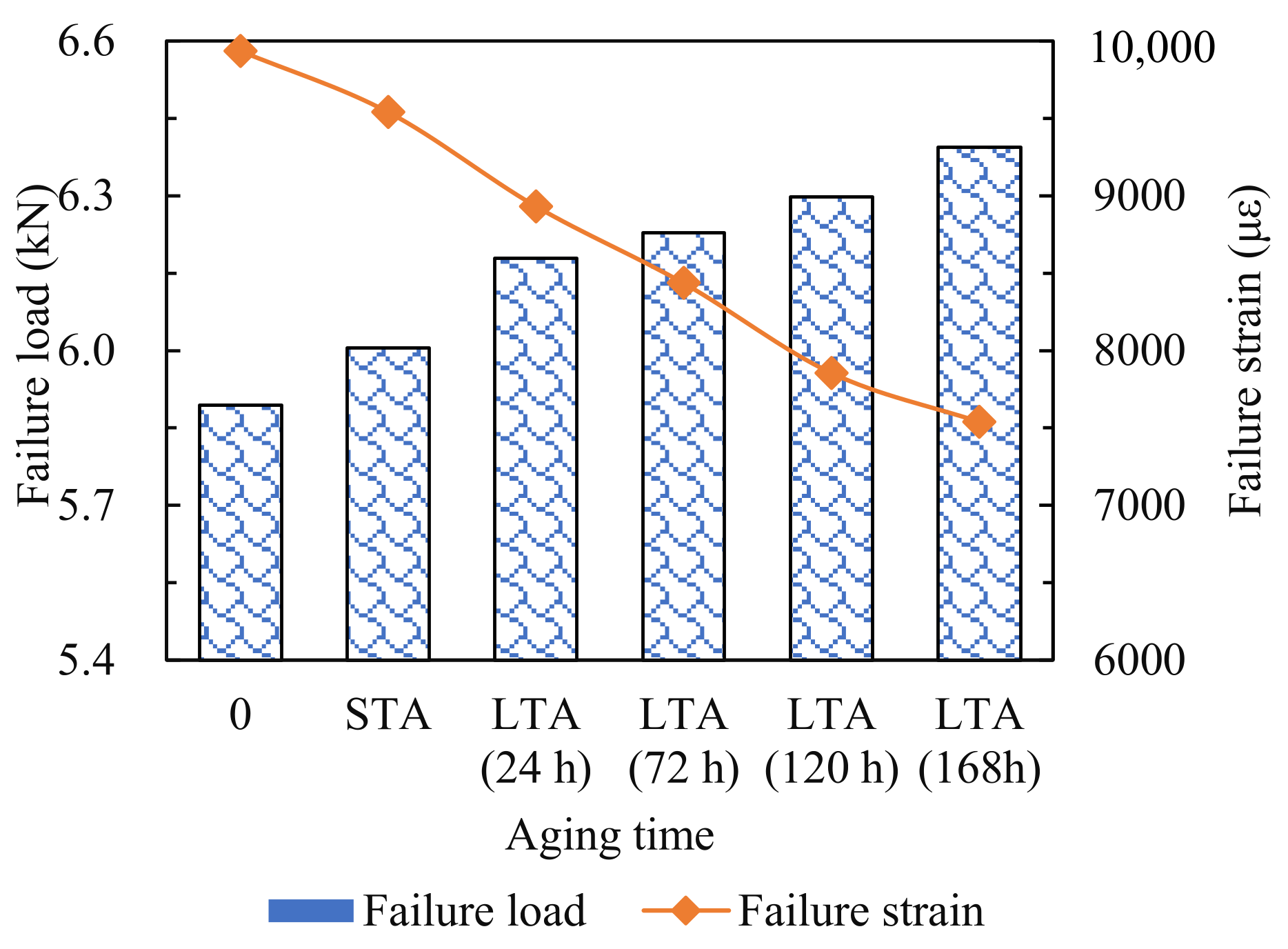



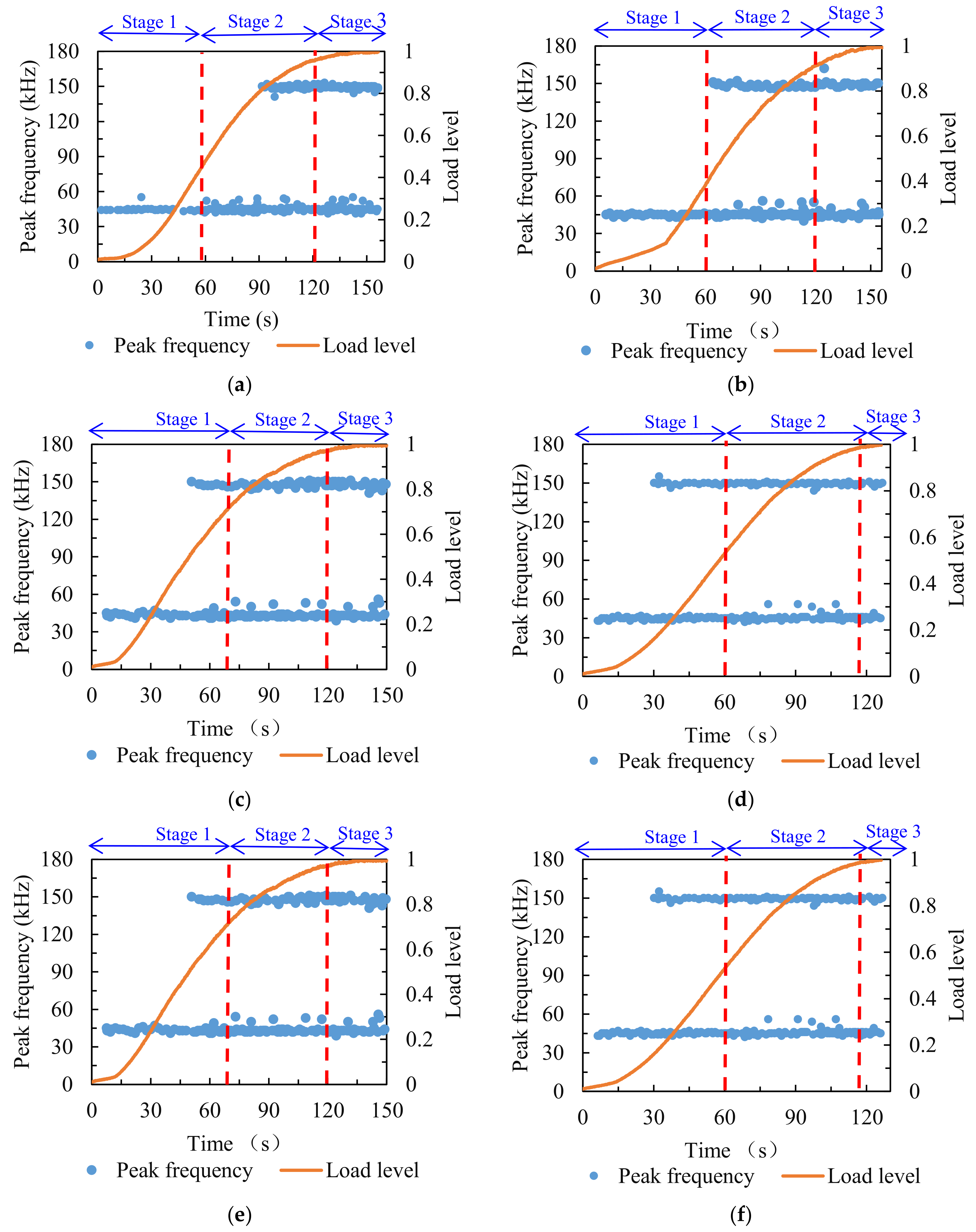
| Test Indicators | Test Values | Technical Requirements | Test Methods |
|---|---|---|---|
| Penetration (25 °C, 0.1 mm) | 63.7 | 60~80 | T0604 |
| Softening point (°C) | 62.2 | ≥55 | T0606 |
| Ductility (5 °C, cm) | 35.6 | ≥30 | T0605 |
| Density (g/cm3) | 1.072 | - | T0603 |
| Flashing point (°C) | 272 | ≥230 | T0611 |
| Elastic recovery (25 °C, %) | 75.3 | ≥65 | T0662 |
| Test Indicators | Test Values | Technical Requirements | Test Methods | |
|---|---|---|---|---|
| Coarse aggregate | Crushing value (%) | 15.2 | ≤26 | T0316 |
| Los Angeles abrasion value (%) | 19.3 | ≤28 | T0317 | |
| Apparent specific gravity | 2.97 | ≥2.6 | T0304 | |
| Fine aggregate | Mud content (%) | 1.2 | ≤3.0 | T0333 |
| Apparent specific gravity | 2.85 | ≥2.5 | T0304 | |
| Mineral powder | Hydrophilic coefficient | 0.6 | ≤1.0 | T0353 |
| Apparent specific gravity | 2.73 | ≥2.5 | T0304 | |
Publisher’s Note: MDPI stays neutral with regard to jurisdictional claims in published maps and institutional affiliations. |
© 2021 by the authors. Licensee MDPI, Basel, Switzerland. This article is an open access article distributed under the terms and conditions of the Creative Commons Attribution (CC BY) license (https://creativecommons.org/licenses/by/4.0/).
Share and Cite
Fu, L.; Zhou, H.; Yuan, J.; An, W.; Chen, X. Damage Fracture Characterization of Asphalt Mixtures Considering Freeze–Thaw Cycling and Aging Effects Based on Acoustic Emission Monitoring. Materials 2021, 14, 5930. https://doi.org/10.3390/ma14205930
Fu L, Zhou H, Yuan J, An W, Chen X. Damage Fracture Characterization of Asphalt Mixtures Considering Freeze–Thaw Cycling and Aging Effects Based on Acoustic Emission Monitoring. Materials. 2021; 14(20):5930. https://doi.org/10.3390/ma14205930
Chicago/Turabian StyleFu, Liuxu, Huanyun Zhou, Jing Yuan, Weiliang An, and Xianhua Chen. 2021. "Damage Fracture Characterization of Asphalt Mixtures Considering Freeze–Thaw Cycling and Aging Effects Based on Acoustic Emission Monitoring" Materials 14, no. 20: 5930. https://doi.org/10.3390/ma14205930
APA StyleFu, L., Zhou, H., Yuan, J., An, W., & Chen, X. (2021). Damage Fracture Characterization of Asphalt Mixtures Considering Freeze–Thaw Cycling and Aging Effects Based on Acoustic Emission Monitoring. Materials, 14(20), 5930. https://doi.org/10.3390/ma14205930






